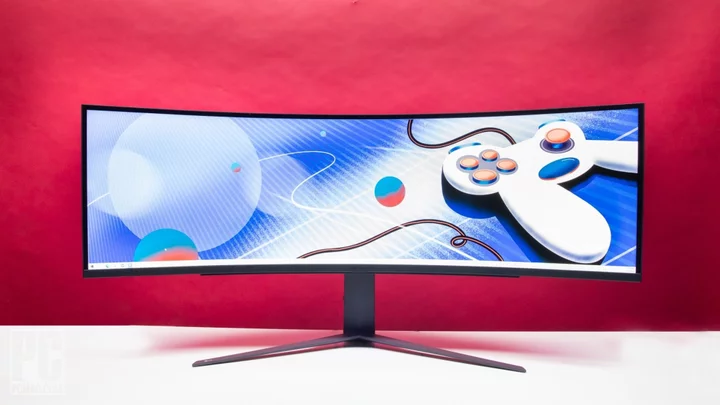LG has its fingers in all sorts of products, from home goods to TVs, but gamers may know the company best as the maker of the UltraGear line of gaming monitors. Promising high visual fidelity with low input lag, the UltraGear line has proven itself dependable, with the LG 45 UltraGear OLED Curved Gaming Monitor winning an Editors' Choice award. The LG 49 Curved UltraGear ($1,299) reviewed here is a little different than that OLED stunner, catering to enthusiast gamers who value widescreen gaming with as little input lag as possible and are willing to forgo OLED technology to save some cash. The dual quad HD (5,120-by-1,440-pixel) curved monitor is a worthy buy for those who want immersion on the more affordable end of the spectrum, as OLED variants like the Samsung Odyssey OLED G9 can cost almost double the price.
The Design: Deep Curve Ahead
LG’s UltraGear sets itself apart with its ultra-tight curve, bending to 1,000mm. Expressed as "1000R," the number is the radius of a circle that would be created by a hypothetical ring of these monitors placed edge to edge. The smaller the number, the tighter the curve. It’s said that lower numbers better mimic the natural curvature of the eye, and thus are more accommodating to the natural depth of human eyesight. Though curved monitors don’t often dip below 1000mm, we've seen a few curve even further, like the bendable Corsair Xeneon Flex (which bends to 800R) and LG’s own bendable 42-inch gaming display, the OLED Flex (which bends to 900R).
(Credit: Joseph Maldonado)The benefit of a tighter curve, outside of the media-watching or gaming immersion factor, is improved image quality. LG’s ultrawide takes the pursuit of quality even further by opting for a VA panel instead of an IPS one that is most common for gaming displays. On average, VA panels do offer better contrast and deeper black levels than their IPS cousins, but they typically falter when it comes to color accuracy and input lag (which we’ll examine later in the review). But VA panels are for the immersion-seeking gamer, so it makes sense for LG to opt for that kind of display to pair with the tighter curve.
(Credit: Joseph Maldonado)Of course, both pale in comparison to a the quality of an OLED display. While an OLED screen might blow the competition out of the water in terms of power efficiency, color gamut, and viewing angles, OLED's price tag weighs heavy. Even smaller, 27-inch OLEDs like the Corsair Xeneon 27QHD240 OLED can cost around $1,000, just a stone’s throw from the already-pricey $1,300 of the 49-inch UltraGear.
The virtually borderless design lends this expansive monitor even more space to breathe, and the dual quad HD resolution does provide some excellent visuals, even if it doesn’t quite touch that coveted 4K resolution (at around 7.3 million overall pixels, versus roughly 8.2 million for 4K). The resolution pairs nicely with midrange PC builds and should resonate with gamers who would rather get the most performance out of their games and are perfectly fine playing at 1080p or 1440p.
(Credit: Joseph Maldonado)Display aside, the UltraGear is quite chunky, especially compared with the Samsung Odyssey OLED G9. The LG's bulkier gray frame measures 18.3 by 46.1 by 15.5 inches (HWD), while the Odyssey OLED G9 is 20.8 by 47.0 by 9.3 inches (HWD). In terms of weight, you’re looking at 32.5 pounds with the stand and 26.5 pounds without, if you feel inclined to mount your monitor on a third-party stand or (very sturdy) arm. You can adjust the height by up to 4.3 inches, tilt it from -5 to 15 degrees, and swivel the panel across a range from -15 to 15 degrees.
Turning the monitor around, you’ll find a bulky hexagon that houses the monitor’s ports. Here you’ll find two USB Type-A ports, two HDMI 2.1 ports, one DisplayPort, and one USB Type-B upstream port. The hefty protrusion back here also includes some RGB lighting that reflects well across the monitor’s wingspan. Just underneath, you’ll find an OSD control stick and a headphone port that supports DTS Headphone X. The latter spec claims to provide accurate specialization and localization in games with 3D audio over headphones. It also supports channel-based, scene-based, and object-based audio—but to take advantage, you will need headphones that support it, as well.
(Credit: Joseph Maldonado)The screen also supports picture-in-picture and picture-by-picture modes, welcome features in big screens that should please multi-monitor users looking to consolidate to one broad panel. Using multiple input sources, you can play, watch, stream, and work at the same time on one monitor, with separate windows either side by side or nested within one another.
Testing the LG 49 Curved UltraGear: An Ultra-Responsive Sweep
The ultrawide UltraGear wants to court widescreen enthusiasts, but does it have what it takes to stand up to the competition? To see how the monitor fares, we pit it against a few of its contemporaries in a benchmark gauntlet that measures color gamut, brightness, color accuracy, contrast ratio, and input lag. While we haven’t tested many other 32:9 screens, we have seen plenty of non-OLEDs and OLEDs with 21:9 ratios, so we broke out our big screen favorites, including our Editors’ Choice pick for the category, the Alienware 34 Curved QD-OLED Gaming Monitor (AW3423DWF), to see how they compare.
First, we tested the monitor in its default picture mode with an SDR signal using a Datacolor SpyderX colorimeter. The LG 49 UltraGear saw an average brightness of 452 nits (candelas per square meter), which almost exactly hits LG’s 450-nit rating. That’s brighter than all of our comparison monitors, with the exception of the ViewSonic Elite XG341C-2K.
Hopping over to HDR mode, we used the VESA DisplayHDR compliance tests (available for free on the Microsoft Store) to measure a peak HDR brightness of 769 nits, well under the monitor’s VESA DisplayHDR 1000 rating. You could perhaps get closer to 1,000 nits of peak HDR brightness with some setting tweaks (keep in mind, all of our testing is done on default, out-of-the-box settings).
Next, we examine the monitor’s color-gamut coverage. The 49-inch UltraGear spanned 100% of the sRGB color gamut, 87% of Adobe RGB, and 92% of DCI-P3. Those are great ratings, though they're not perfect, being bested by the ViewSonic Elite XG341C-2K, another VA panel, and all of the OLED competitors. Still, the 49-inch UltraGear is no slouch, and posted better results than the ASRock Phantom Gaming 34.
Regarding color accuracy, the 49-inch UltraGear recorded a Delta E of 1.8. The higher the Delta E, the more the colors tend to stray from their intended hue. A value under 1 is ideal, though most gaming monitors don’t really get near that number, especially out of the box. So this is a fine showing.
(Credit: Joseph Maldonado)Next up: the contrast ratio, which indicates the difference in luminance between the brightest white and darkest black that a monitor can produce. It makes a difference in picture quality, especially during dark scenes in gameplay. We measured a contrast ratio of 1,820:1 and a black level of 0.25. That's a fine showing for a non-OLED, even if it falls just short of LG’s rated minimum contrast ratio of 2,000:1. The rather low black level is a testament to the limitations of the monitor’s VA panel.
Media and Gaming Performance
What about the most important metric for a gaming monitor: input lag? To quantify that, we use an HDFury Diva HDMI matrix to take an input lag measurement, and play a handful of games from our library to see if there are any noticeable blemishes like screen tearing.
The good news is that you don’t have to worry about gaming performance here. We measured less than 1 millisecond (ms) of input lag, an excellent result, especially if you prefer your games to be competitive. Fans of fast-paced first-person shooters will appreciate this metric coupled with the 240Hz refresh rate. Support for AMD's Freesync Premium Pro adaptive sync is also included, which should eliminate any potential screen tearing. In addition, a few additional gaming features come baked into the screen, like a Black Stabilizer and an FPS Counter.
(Credit: Joseph Maldonado)Additional testing included playing bouts of Cyberpunk 2077 and Returnal. A word of caution to those interested in widescreen gaming: Not every new PC release supports it, and games that do support a 21:9 aspect ratio may not stretch to 32:9 (like Diablo IV). To get the most out of your ultrawide gaming experience, make sure your games adjust to your monitor accordingly.
Verdict: Ultrawide Gaming for the Competitive Gamer
LG’s 49-inch Curved UltraGear Gaming Monitor strikes a fine balance between excellent gaming performance and color range, and its tight curve is sure to impress gamers who prefer their games to be ultrawide. Its cabinet is bulkier than we’d like, but the panel delivers where it matters the most.
At $1,299, it is expensive, but it’s easier to stomach the price when compared with OLED alternatives like the Samsung Odyssey OLED G9, or even other non-OLED ultrawide monitors like ViewSonic's Elite XG341C-2K. If you’re on the hunt for the widest wingspan for the smallest dollar amount, the LG 49 Curved UltraGear Gaming Monitor more than gets the job done.









